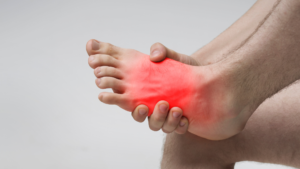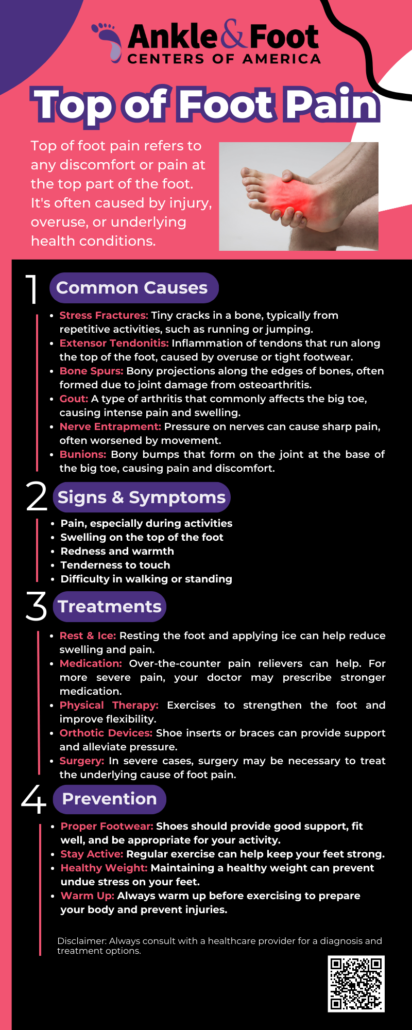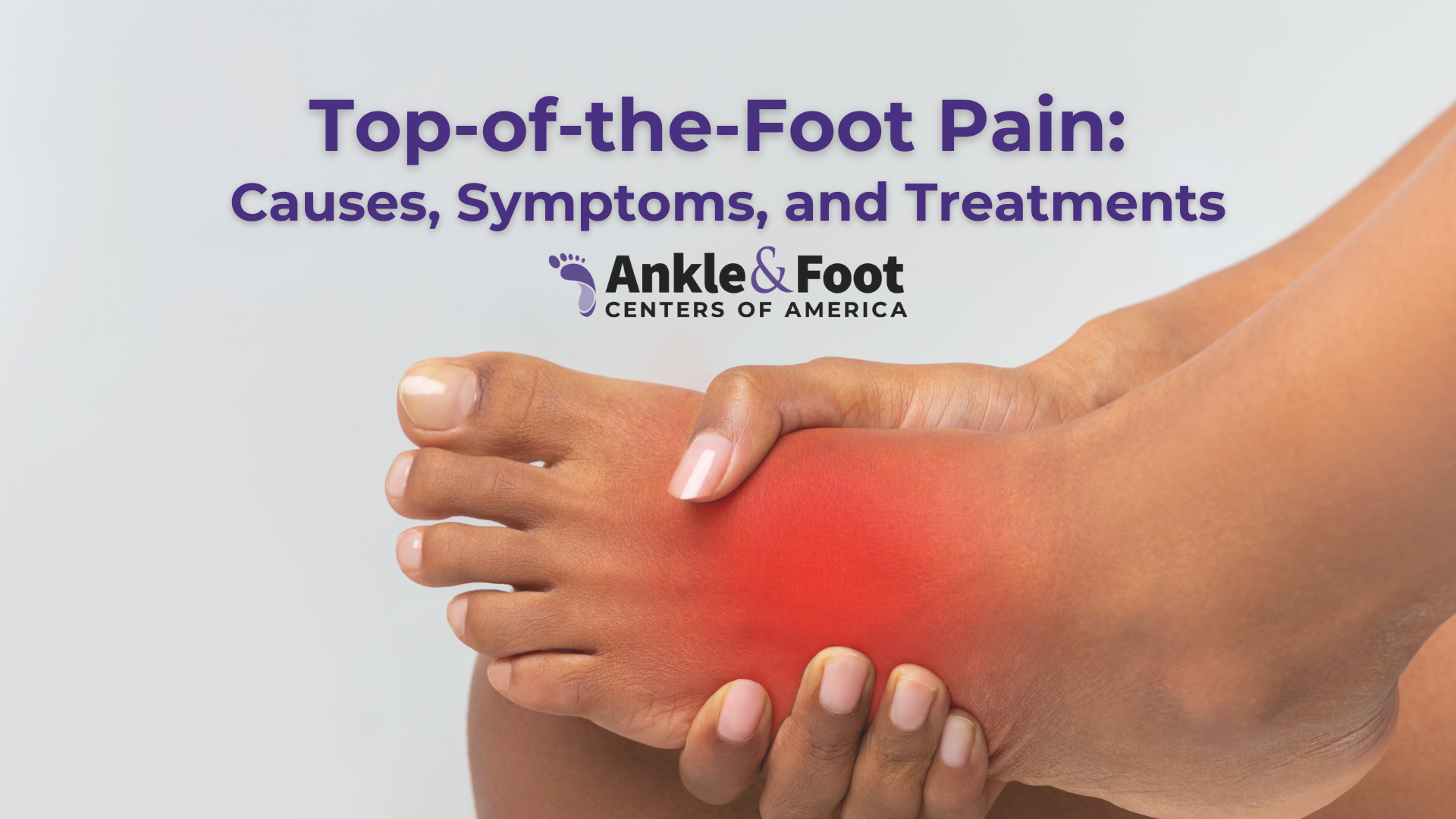Top of foot pain can be a perplexing and debilitating issue, impacting daily life and undermining comfort. But what if we told you that understanding the underlying causes, symptoms, and treatment options could help you manage or even prevent this discomfort? In this blog post, we will delve into the complexities of top of foot pain and offer valuable insights to help you take control of your foot health.
Table of Contents
Short Summary
- Accurately assess type, location & symptoms of top of foot pain to identify cause and seek treatment.
- Common causes are overuse injuries, structural issues & medical conditions. Uncommon causes include tarsal coalition & ganglion cysts.
- Treatment options range from home remedies to professional care or surgical interventions depending on severity and underlying cause.
Identifying Top of Foot Pain
It’s crucial to recognize that top of foot pain can manifest in various forms, stemming from bones, soft tissues, or certain medical conditions. By understanding the differences between acute and chronic pain, the location of the pain, and associated symptoms, we can better identify the root cause and seek appropriate treatment.
It is important to note that the type of treatment to relieve pain and reduce pain will depend on the underlying cause of the burning pain.
Acute vs. Chronic Pain
Acute pain is like a sudden, unwelcome guest, causing severe discomfort and often resulting from stress fractures or midfoot injuries. Imagine stepping on a sharp object or dropping a heavy item on your foot – the immediate, intense pain is acute in nature and makes your foot hurt. On the other hand, chronic pain lingers like an unwanted houseguest, persisting for long periods and often caused by structural issues or health conditions. The gradual onset of discomfort after a long day on your feet or the nagging ache that worsens over time characterizes chronic pain.
Knowing the difference between these types of pain is crucial in determining the underlying cause and getting the right care. For instance, acute pain from a stress fracture may require rest and a walking boot, while chronic pain from flat feet might benefit from custom orthotics or physical therapy.
Location of Pain
Pinpointing the location of foot pain is like solving a mystery, with each clue leading closer to the underlying cause. Some possible causes of foot pain include:

- Toe deformities
- Extensor tendonitis
- Morton’s neuroma
- Plantar fasciitis
- Achilles tendonitis
- Stress fractures
If you’re experiencing foot pain in your affected foot, it’s important to consult with a healthcare professional for an accurate diagnosis and appropriate treatment.
Extensor tendonitis, an inflammation of the extensor tendons on the top of the foot, can be caused by various factors such as prolonged standing or walking, muscle tightness, and off-road running. The pressure from tight shoes can exacerbate the discomfort, making it crucial to wear suitable footwear and take preventive measures to alleviate the pain.
Associated Symptoms
When it comes to top of foot pain, associated symptoms can be invaluable clues in identifying the root cause. Some common symptoms to look out for include:
- Swelling
- Redness
- Numbness
- Visible bump
These symptoms might point to different conditions such as nerve pain or a ganglion cyst.
Peripheral neuropathy is a condition characterized by pain and/or foot weakness or numbness on the top of the foot. This is often caused by compression of a nerve in the foot, leg, or lower back due to a pinched nerve. By recognizing these associated symptoms, we can seek the most effective treatment options, ranging from:
- Home remedies
- Physical therapy
- Medications
- Nerve blocks
- Surgical interventions
Common Causes of Top of Foot Pain
Some of the most common causes of top of foot pain include overuse injuries, structural issues, and medical conditions. Overuse injuries, such as stress fractures and tendonitis, typically result from repetitive activities or poor footwear choices, while structural issues like flat feet, arthritis, and toe deformities can cause ongoing discomfort.
Medical conditions like gout, diabetes, and peripheral neuropathy may also contribute to top of foot pain.
Overuse Injuries
Overuse foot injuries, such as ankle sprain, occur when we push our feet beyond their limits, leading to stress fractures and tendonitis. Athletes, runners, and individuals who engage in high-impact activities, like jumping or kicking, are particularly susceptible to these injuries.
Preventing overuse injuries involves taking breaks from repetitive activities, wearing well-fitting shoes, and stretching before and after physical activity. By being mindful of our bodies and incorporating preventive measures, we can help reduce the risk of overuse injuries and maintain our foot health.
Structural Issues
Structural issues within our feet can also be a source of pain. Flat feet, for example, can lead to discomfort on the top of the foot due to the lack of arch support. Arthritis is an inflammation of the joints. This can cause pain in the metatarsophalangeal joint (MCP) located at the base of the big toe, resulting in top of foot pain.
Toe deformities, such as hammer, claw, or mallet toe, can also contribute to top of foot pain. Addressing these structural issues through proper footwear, orthotics, and physical therapy can help alleviate discomfort and improve overall foot health.
Medical Conditions
Medical conditions can also play a significant role in top of foot pain. Gout, a form of inflammatory arthritis, is characterized by the formation of uric acid crystals in joints, often affecting the big toe and causing intense pain. Diabetes, on the other hand, can lead to peripheral neuropathy, resulting in pain and numbness in the feet.
Understanding the connection between these medical conditions and top of foot pain allows us to seek appropriate treatment and manage our symptoms effectively. For instance, gout may be treated with prescription medication to block uric acid production, while managing diabetes through a healthy diet and regular exercise can help alleviate foot pain.
Uncommon Causes of Top of Foot Pain
While overuse injuries, structural issues, and medical conditions are common causes of top of foot pain, less frequent causes, such as tarsal coalition and ganglion cysts, also exist. Tarsal coalition, a condition where two or more middle bones of the foot are abnormally fused together, can cause pain, fatigue, and muscle cramps.
Ganglion cysts, small lumps filled with jelly-like fluid, can also lead to pain when pressing against muscles, joints, or nerves in the foot. Identifying and treating these uncommon causes is essential to ensure proper care and recovery.
Diagnosing Top of Foot Pain
Diagnosing top of foot pain typically involves a physical examination, observation of walking patterns, and imaging tests like X-rays or MRIs. A qualified podiatrist will inspect the foot for signs of swelling or malformation, observe the patient’s gait, and assess movement and strength in and around the foot.
If necessary, additional tests, such as blood tests or imaging, may be recommended to identify the underlying cause and determine the most appropriate course of treatment.
Treatment Options for Top of Foot Pain
Once the cause of top of foot pain has been identified, a range of treatment options may be considered, including home remedies, professional care, and surgical interventions. The choice of treatment depends on the severity of the pain and the underlying cause, with the ultimate goal being to alleviate discomfort and improve overall foot health.
Home remedies may include rest, ice, compression, and elevation. Professional care may involve physical therapy.
Home Remedies
Home remedies can be effective in addressing minor top of foot pain, offering relief without the need for professional intervention. Rest, ice, elevation, and over-the-counter pain relievers can be used to alleviate discomfort and reduce inflammation.
For individuals with extensor tendonitis, loosening shoelaces or adding padding to shoes can provide additional relief by reducing pressure on the inflamed tendons. Incorporating these home remedies into your daily routine can help manage top of foot pain and promote a faster recovery.
Professional Care
In more severe cases or when home remedies fail to provide relief, professional care may be necessary. This can include:
- Physical therapy to strengthen foot muscles and improve flexibility
- Custom orthotics to provide additional support
- Prescription medications to manage pain and inflammation
Primary care doctors can provide guidance on the most appropriate treatment options based on the underlying cause of top of foot pain. By seeking professional care, patients can ensure they receive the best possible treatment to alleviate their discomfort and improve their overall foot health.

Surgical Interventions
In some cases, surgical interventions may be necessary to address top of foot pain, particularly when conservative treatments have been unsuccessful or the injury is severe. Surgical procedures, such as open reduction and internal fixation (ORIF), arthrodesis, and osteotomy, can be used to treat midfoot injuries and bone fractures.
While surgery carries potential risks, such as infection, nerve damage, and blood clots, it can also provide significant benefits by improving mobility and alleviating pain. Consulting with a healthcare professional can help determine if surgery is the most appropriate course of action for your specific situation.
Prevention Tips
Preventing top of foot pain involves taking proactive measures, such as wearing proper footwear, maintaining a healthy weight, and incorporating stretching and strengthening exercises into your daily routine. For individuals with diabetes, checking feet daily for signs of irritation or infection, wearing well-fitting shoes, and soaking feet in warm water can help prevent complications that may lead to top of foot pain.
By adopting these preventive measures, we can help safeguard our foot health and minimize the risk of experiencing top of foot pain in the future, especially when we position our foot upward.

Conclusion
Understanding the various causes, symptoms, and treatment options for top of foot pain is essential for ensuring proper care and recovery. By recognizing the subtle differences between acute and chronic pain, identifying the location of discomfort, and seeking appropriate treatment, we can take a proactive approach to managing our foot health.
Whether you’re experiencing minor discomfort or more severe pain, being knowledgeable about top of foot pain can empower you to make informed decisions and take control of your well-being.
Summary
 In summary, top of foot pain can be a complex issue with various causes, symptoms, and treatment options. By understanding these factors and implementing prevention strategies, we can take control of our foot health and minimize discomfort. Whether you’re dealing with minor pain or more severe issues, being knowledgeable about top of foot pain can empower you to make informed decisions and seek appropriate care for a successful recovery.
In summary, top of foot pain can be a complex issue with various causes, symptoms, and treatment options. By understanding these factors and implementing prevention strategies, we can take control of our foot health and minimize discomfort. Whether you’re dealing with minor pain or more severe issues, being knowledgeable about top of foot pain can empower you to make informed decisions and seek appropriate care for a successful recovery.
Frequently Asked Questions
What does tendonitis feel like on top of the foot?
Pain along the top of the foot, especially when running or walking, is the most common symptom of extensor tendonitis in the foot. Swelling, tenderness, warmth and a visible bump may also be present.
Can plantar fasciitis cause pain at the top of the foot?
Plantar fasciitis can cause pain in the top of the foot, but it is not as common as heel pain or stiffness.
Typically, if someone with plantar fasciitis experiences pain on the top of the foot, they will also have heel pain and stiffness.
What is metatarsal pain in the top of the foot?
Metatarsal pain in the top of the foot is caused by stress fractures, arthritis, inflammation from running/jumping activities, foot deformities and shoes that are too tight or too loose.
It typically results in sudden onset of swelling and tenderness in the area just behind the toes.
Can you get gout on top of your foot?
Yes, you can get gout on top of your foot. Gout usually causes intense pain that comes on quickly in the affected area, as well as redness, swelling, or tenderness.
These symptoms can be very uncomfortable and can make it difficult to walk or move the affected area. Treatment for gout usually involves medications to reduce inflammation.
Are there any exercises or stretches that can help relieve top of foot pain?
Yes, stretching the muscles and tendons in the top of the foot can help reduce pain and improve mobility, making it a great way to alleviate top of foot pain.
Stretching can be done in a variety of ways, such as using a foam roller, using a tennis ball, or using a stretching band. Each of these methods can help to target specific muscles and tendons in the top of the foot.
Additional Information
What are the typical causes of top of foot pain? Common causes of top of foot pain include overuse injuries, structural issues, and medical conditions, such as stress fractures, tendonitis, flat feet, arthritis, gout, and peripheral neuropathy.
How is top of foot pain diagnosed? Diagnosis involves a physical examination, observation of walking patterns, and imaging tests like X-rays or MRIs to identify the underlying cause.
What are the available treatment options for top of foot pain? Treatment options range from home remedies, such as rest, ice, and over-the-counter pain relievers, to professional care like physical therapy, custom orthotics, and prescription medications. In some cases, surgical interventions may be necessary.
Can wearing particular types of shoes result in top of foot pain? Yes, wearing shoes that are too tight or have a high heel can place additional pressure on the top of the foot and may cause pain.
How long does it take for top of foot pain to heal? The duration of top of foot pain healing depends on the underlying cause and intensity of the pain. In some cases, it may take several weeks or months for the pain to dissipate.





